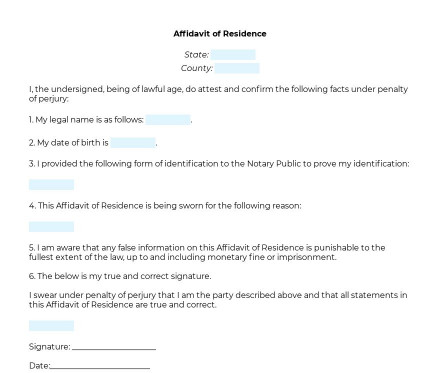Affidavit of Residence Free
When an individual affirms their own residence or someone affirms the prior residence of a deceased person, this Affidavit of Residence can be used.


 Template Overview
Template Overview
When an individual affirms their own residence or someone affirms the prior residence of a deceased person, this Affidavit of Residence can be used. In the material, the person filling the document must not only verify that the statements in the Affidavit are correct, but they must also produce identification before a Notary Public to have the document notarized.
These documents very often used for the purpose of distributing a decedent's property after their death, and they are sometimes called Affidavits of Domicile.
Affidavits of Residence consists of information about either the affiant for their own personal uses or the affiant and the decedent:
1. Full legal name;
2. Full address;
3. Facts surrounding the residence;
4. Document name and if applicable, number verifying the ID of the affiant;
5. The reason the Affidavit is needed.
You fill out a form. The document is created before your eyes as you respond to the questions.
At the end, you receive it in Word and PDF formats. You can modify it and reuse it.
 How to use this template
How to use this template
When an individual needs a form to verify their residence, they can use this document. A document can also be used for a disinterested party to confirm the residence of a decedent for any purpose. A disinterested party is a person that will not inherit anything from the decedent's estate and who has no other interest in the decedent's estate.
A completed document should be notarized - that means the affiant signs before a Notary Public, after providing valid legal identification.
 Applicable law
Applicable law
No specific set of laws govern Affidavits of Residence, but it will depend on the situation for which it is needed. This form contains all of the required information for any case where residence or domicile needs to be verified.
Ready to build your document from this template?


 Please wait
Please wait
